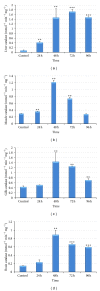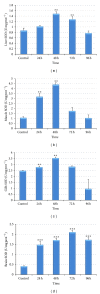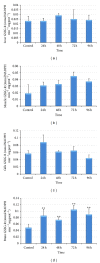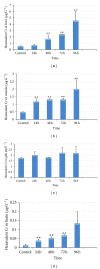The applicability of oxidative stress biomarkers in assessing chromium induced toxicity in the fish Labeo rohita
- PMID: 25302308
- PMCID: PMC4180195
- DOI: 10.1155/2014/782493
The applicability of oxidative stress biomarkers in assessing chromium induced toxicity in the fish Labeo rohita
Abstract
The evaluation of metal's toxicity in freshwater is one of the imperative areas of research and there is an emergent concern on the development of techniques for detecting toxic effects in aquatic animals. Oxidative stress biomarkers are very useful in assessing the health of aquatic life and more in depth studies are necessary to establish an exact cause effect relationship. Therefore, to study the effectiveness of this approach, a laboratory study was conducted in the fish Labeo rohita as a function of hexavalent chromium and the toxicity indices using a battery of oxidative stress biomarkers such as catalase (CAT), superoxide dismutase (SOD), and glutathione reductase (GR) in the liver, muscle, gills, and brain have been studied along with biometric parameters, behavioral changes, and Cr bioaccumulation. A significant increased HSI was observed in contrast to CF which reduced significantly. SOD, CAT, and GR activity increased significantly in all the tissues of treated fishes. The bioaccumulation of Cr was highest in liver followed by gills, muscle, and brain. This study highlights the significance of using a set of integrated biomarker and advocate to include these parameters in National Water Quality Monitoring Program in areas potentially polluted with metals to assess the health of the ecosystem.
Figures







Similar articles
-
Hexavalent chromium induced bioaccumulation, oxidative responses and histological anomalies in freshwater carp Labeo rohita (Hamilton, 1822).Biometals. 2025 Aug;38(4):1315-1335. doi: 10.1007/s10534-025-00708-3. Epub 2025 Jun 24. Biometals. 2025. PMID: 40553265
-
Evaluation of DNA Damage, Biomarkers of Oxidative Stress, and Status of Antioxidant Enzymes in Freshwater Fish (Labeo rohita) Exposed to Pyriproxyfen.Oxid Med Cell Longev. 2022 Jun 10;2022:5859266. doi: 10.1155/2022/5859266. eCollection 2022. Oxid Med Cell Longev. 2022. PMID: 35720182 Free PMC article.
-
Iron mediated hematological, oxidative and histological alterations in freshwater fish Labeo rohita.Ecotoxicol Environ Saf. 2019 Apr 15;170:87-97. doi: 10.1016/j.ecoenv.2018.11.129. Epub 2018 Dec 4. Ecotoxicol Environ Saf. 2019. PMID: 30529624
-
[Mechanisms of Cr (VI) toxicity to fish in aquatic environment: A review].Ying Yong Sheng Tai Xue Bao. 2015 Oct;26(10):3226-34. Ying Yong Sheng Tai Xue Bao. 2015. PMID: 26995935 Review. Chinese.
-
An Update Overview on Mechanistic Data and Biomarker Levels in Cobalt and Chromium-Induced Neurodegenerative Diseases.Biol Trace Elem Res. 2024 Aug;202(8):3538-3564. doi: 10.1007/s12011-023-03965-w. Epub 2023 Nov 28. Biol Trace Elem Res. 2024. PMID: 38017235 Review.
Cited by
-
A systematic review of approaches to assess fish health responses to anthropogenic threats in freshwater ecosystems.Conserv Physiol. 2024 May 4;12(1):coae022. doi: 10.1093/conphys/coae022. eCollection 2024. Conserv Physiol. 2024. PMID: 38706739 Free PMC article.
-
Oxidative Stress Biomarkers in Fish Exposed to Environmental Concentrations of Pharmaceutical Pollutants: A Review.Biology (Basel). 2025 Apr 25;14(5):472. doi: 10.3390/biology14050472. Biology (Basel). 2025. PMID: 40427661 Free PMC article. Review.
-
Hesperidin ameliorates hepatic dysfunction and dyslipidemia in male Wistar rats exposed to cadmium chloride.Toxicol Rep. 2020 Oct 3;7:1331-1338. doi: 10.1016/j.toxrep.2020.09.014. eCollection 2020. Toxicol Rep. 2020. PMID: 33088721 Free PMC article.
-
The physiological effects of acute and sub-lethal exposure to phenol on antioxidant enzyme activity in the freshwater sludge worm Tubifex tubifex.Toxicol Rep. 2024 Aug 23;13:101717. doi: 10.1016/j.toxrep.2024.101717. eCollection 2024 Dec. Toxicol Rep. 2024. PMID: 39280992 Free PMC article.
-
Interactions of oxidative DNA damage and CYP1A gene expression with the liver enzymes in Klunzinger's mullet exposed to benzo[a]pyrene.Toxicol Rep. 2019 Oct 19;6:1097-1103. doi: 10.1016/j.toxrep.2019.10.013. eCollection 2019. Toxicol Rep. 2019. PMID: 31720230 Free PMC article.
References
-
- Gbem TT, Balogun JK, Lawal FA, Annune PA. Trace metal accumulation in Clarias gariepinus (Teugels) exposed to sublethal levels of tannery effluent. Science of the Total Environment. 2001;271(1–3):1–9. - PubMed
-
- Leonard SS, Harris GK, Shi X. Metal-induced oxidative stress and signal transduction. Free Radical Biology and Medicine. 2004;37(12):1921–1942. - PubMed
-
- Flora SJS, Mittal M, Mehta A. Heavy metal induced oxidative stress & its possible reversal by chelation therapy. Indian Journal of Medical Research. 2008;128(4):501–523. - PubMed
-
- Chen F, Ding M, Castranova V, Shi X-L. Carcinogenic metals and NF-κB activation. Molecular and Cellular Biochemistry. 2001;222(1-2):159–171. - PubMed
-
- Labonne M, Ben Othman D, Luck J. Pb isotopes in mussels as tracers of metal sources and water movements in a lagoon (Thau Basin, S. France) Chemical Geology. 2001;181(1–4):181–191.
Publication types
MeSH terms
Substances
LinkOut - more resources
Full Text Sources
Other Literature Sources
Miscellaneous

